This post may contain affiliate links. We may receive a small commission, at no cost to you, if you make a purchase. Read Disclosure.
The Daintree Rainforest is a world-heritage-listed rainforest in Tropical Far North Queensland. In fact, it’s the oldest rainforest in the world.
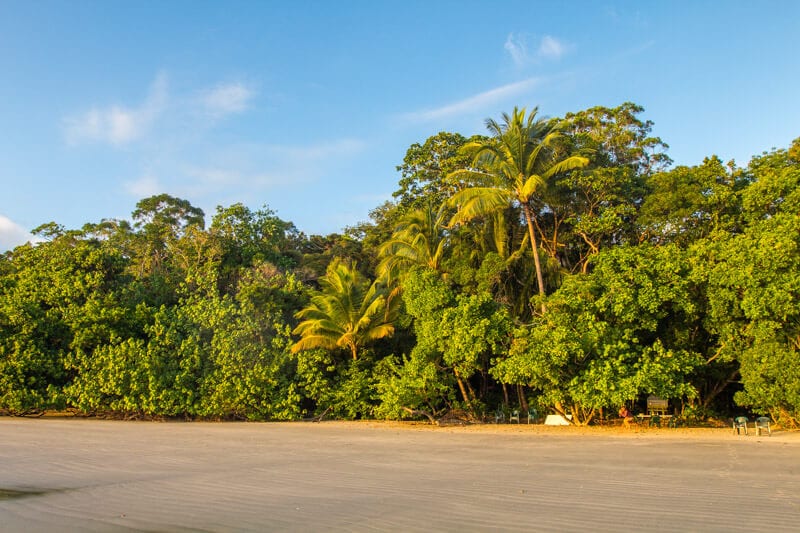
We first visited The Daintree during our 18-month road trip around Australia with our kids, and that experience left us longing for more.
Although many people pass by the Daintree as they travel from Cairns to Cape Tribulation, a visit to this ancient rainforest should not go amiss. With snaking vines and rich, green canopies, the sounds of birds and insects thriving and the trickle of waterfalls and rivers flowing, this is truly a nature lover’s dream come true.
I have no hesitation in listing this ancient and magical rainforest in Tropical North Queensland in our top three places in Australia.
There is no place like it in Australia, possibly the world. But if you’re not sure how to visit the Daintree or what things there are to do, then read on to find out!
- What Is the Daintree Rainforest?
- When is the Best Time to visit the Daintree Rainforest?
- Things to Do In The Daintree Rainforest
- 1. Driving to the Daintree Rainforest
- 2. Go Barra Fishing
- 3. Grab Lunch at Daintree Village Hotel
- 4. Go Croc Spotting on a Daintree River Cruise
- 5. Cross the Daintree River on the Daintree River Ferry
- 6. Visit the Mount Alexandra Lookout
- 7. Discover More at the Daintree Discovery Centre
- 8. Have Lunch at Whet Cafe & Bar
- 10. Walk the Dubuji Boardwalk
- 11. Go Jungle Surfing
- 12. Take A Trip to Cape Tribulation Beach
- 13. Have Dinner at Cape Trib Beach House
- 14. Stay Overnight at Cape Trib Beach House
- 15. Enjoy Sunrise on Cape Tribulation
- 16. Walk to Kulki Lookout
- 17. Have Lunch at Mason's Store & Cafe
- 18. Walk the Marrja Boardwalk
- 19. Try Floravilla Ice Cream
- 20. Thornton Beach Cafe
- 21. Look out for Idiot Fruit
- Where to Stay in The Daintree Rainforest
- Final Word on Visiting The Daintree Rainforest
- Tropical North Queensland Tips
What Is the Daintree Rainforest?

The Daintree is estimated to be over 180 million years old and is the largest continuous area of tropical rainforest (1,200 square kilometres to be exact) on the Australian continent and the oldest living rainforest on earth – even pre-dating the Amazon Rainforest.
Its traditional owners are the Kuku Yalanji people, an aboriginal people tribe, and it resides in the Wet Tropics World Heritage Area in North Queensland.
What else makes it unique? It’s the only place in the world where two World Heritage sites collide, the Daintree Rainforest and the Great Barrier Reef.
It’s also home to a huge diversity of wildlife, including 12,000 species of insect, 30% of Australia’s frog population, and 65% of butterfly species and bats.
You will also find hundreds of bird species, reptiles such as boyd’s forest dragon, and other marsupial species such as Koalas and ring-tailed possums, and of course, saltwater crocodiles.

It also has a rich population of plant species. Australia has 36 mangrove species, and 28 are found in the Daintree region. Not to mention the many flowering plants.
I’ve said it before, and I’ll say it again, how can something so old be so beautiful?
The beauty of the Daintree National Park not only lies with its flora and fauna, its mystery and history, but it’s a place you can escape to, where you can get back to nature and unplug from the chaos of life on a digital detox.
We all need some time out now and again, to get away from the routines and normalcy of life, and the Daintree offers you and your family the chance to present yourself and each other in one of the most magical places in the world.
When is the Best Time to visit the Daintree Rainforest?
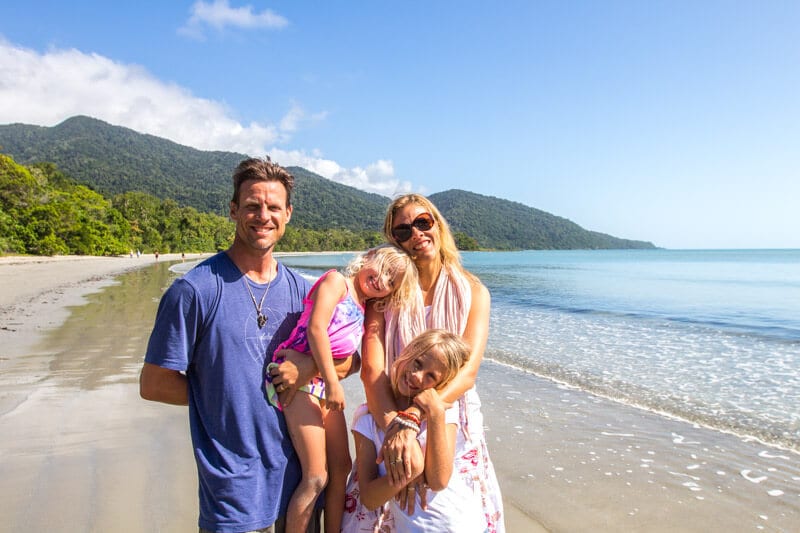
Throughout the year, you can expect a lot of rain in the Daintree (what do you expect from a rainforest?).
But the best time of year to visit is the dry season, which runs from May to September. This is when the weather is best suited for hiking and exploring the outdoor attractions of the national park.
The wet season runs from December to April and brings with it high humidity and a lot of rain. Sometimes as much as 6 metres per year.
Although the rainy season makes the waterfalls lovely and full, it also brings with it road closures and flooding.
The most popular months to visit are May to September. This is when you see the most amount of tourists. Unsurprisingly, the wet season is the low season and sees the least amount of tourists.
Things to Do In The Daintree Rainforest
While it is possible to do a day trip to the Daintree from Port Douglas, I believe that is way too rushed, and it deserves more time.
If you’re thinking you’d like to visit the Daintree Rainforest, here are some of the top things to do and places to visit…
1. Driving to the Daintree Rainforest

You know you are back in Tropical North Queensland and heading for the Daintree when beautiful lush rainforest scenery surrounds you on the side of the road.
If you’re going to visit the oldest rainforest in the world, you might as well sleep in the rainforest and allow yourself time to immerse yourself and discover everything it has to offer.
The Daintree Rainforest is easily accessible to self-drive from Port Douglas. The road is fully sealed all the way to Cape Tribulation (85 kilometres) and a 4wd is not necessary.
It’s hard to get lost, but grab a map from one of the information centres as once you cross the Daintree River, phone reception is non-existent and the maps are handy for points of interest along the way.

About 20 minutes after departing Port Douglas, you will reach the town of Mossman, which is home to Mossman Gorge at the southernmost end of the Daintree Rainforest. Take time to do the Dreamtime Gorge Walk and check out the Mossman River for a bit of standup paddle boarding.
What you can’t miss as you drive through the town of Mossman are those incredible trees int he photo above by the side of the road.
2. Go Barra Fishing
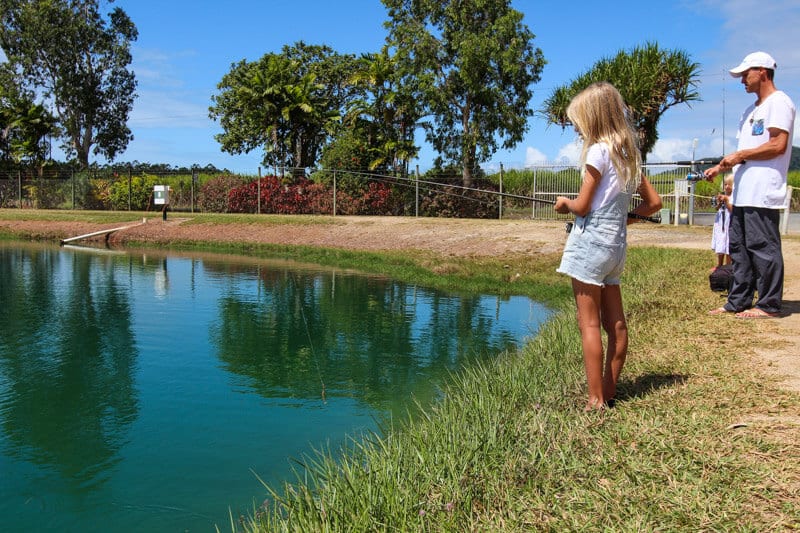
Fancy a spot of fishing? We went spearfishing in Cooya Beach, which was a really fun experience, but have you ever tried barra fishing? This is something a little more unique to the Daintree.
We stopped in at Hook-A-Barra in Wonga Beach, about 35 minutes drive from Port Douglas, to try our hand at landing a barra.
We’re not typically a fishing family but they love it up in Tropical North Queensland and barramundi is a local favourite.
Barramundi is an Australian native species and is beloved of anglers worldwide, not only for its fight but its delicious flavour.

Hook-a-barra is the recreational side of Daintree Saltwater Barramundi Fish Farms, which has been producing Australia’s best hand-reared Barramundi for over a decade. Their ponds are stocked with over 1,500 Barramundi (including albinos) and Mangrove Jack and range in size from 1-12kg.
We grabbed a rod each and started off with a quick casting lesson from the friendly assistant. A few tangled lines later and we were like pros, even little Savannah was casting and reeling her line in like she’s been watching fishing shows for the past five years, not cartoons.
The bites got more frequent and then, to our excitement, bam, Savannah hooked one.
I quickly grabbed the net and Caz the camera, and with a little help from the assistant, Savannah landed this nice 3kg barra that put a smile on her face a metre wide.
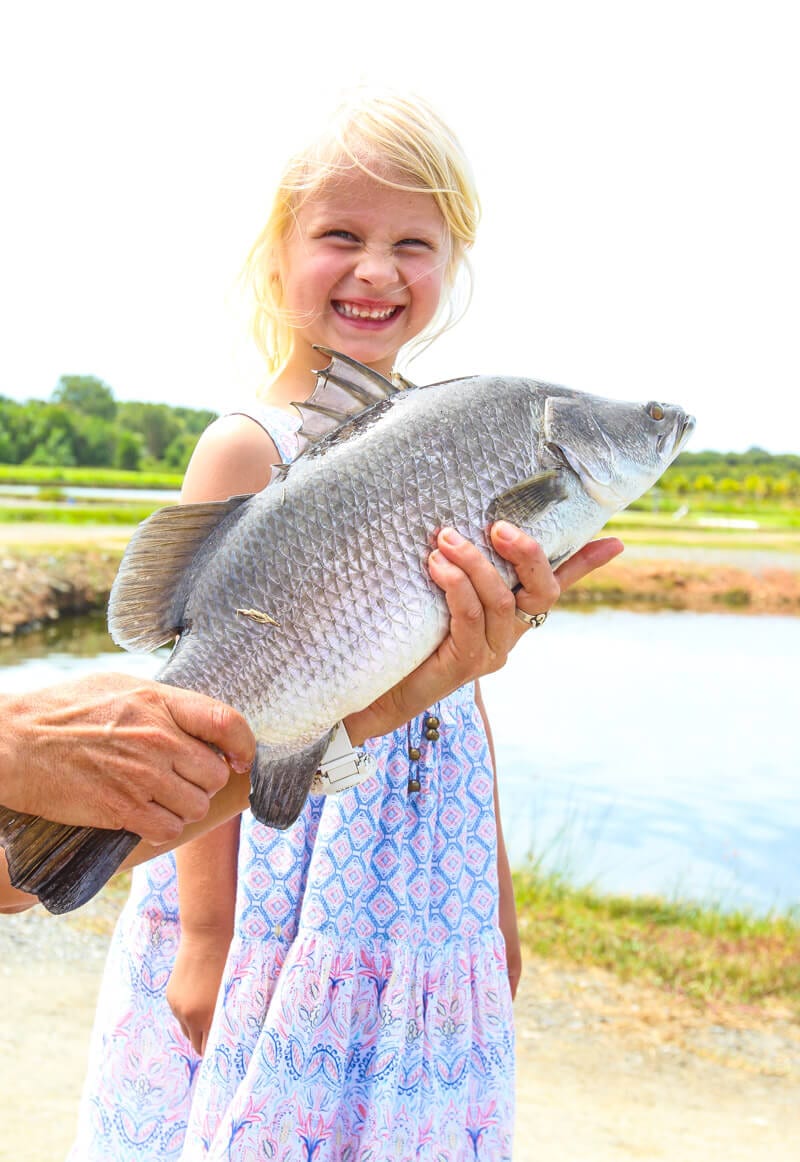
We decided to catch and release. But rest assured, even if you choose to purchase your fish, you are not depleting Australia’s wild stock.
It’s not wild fishing, but a fun introduction and offers anglers of all abilities the chance to practice their lure and land techniques against an idyllic rainforest backdrop.
3. Grab Lunch at Daintree Village Hotel

It was only another 15 minutes drive, and we arrived in the Daintree Village, a charming and peaceful little village that borders the Daintree Rainforest and sits on the southern banks of the Daintree River.
The village was discovered by Europeans in 1873 by Scottish geologist George Elphinstone Dalrymple who named the river and the first settlement, Daintree Village. It was named after Queensland’s British Agent-General, Richard Daintree.
Here you can check out the local shops and art galleries or just sit back and relax and enjoy the village atmosphere.
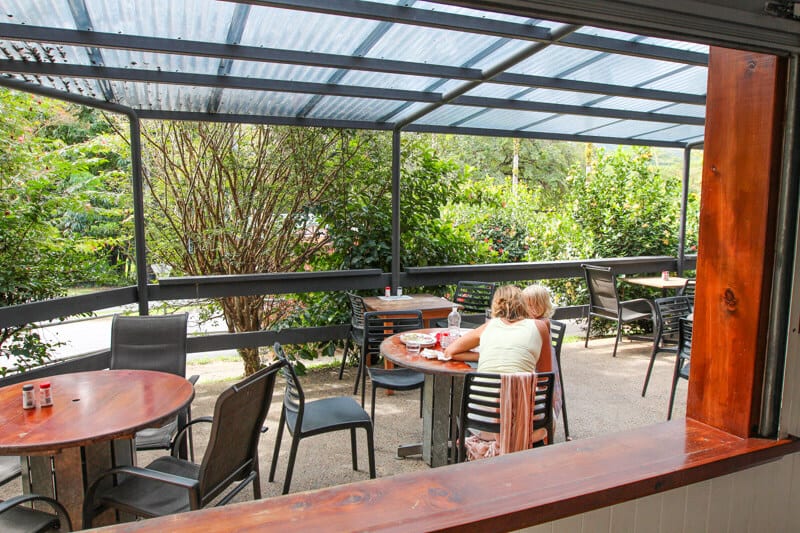

We worked up quite an appetite with all that excitement of fishing, so lunch was in order at the Daintree Village Hotel.
Caz and I enjoyed a mackerel burger in the quiet garden setting, and then Kalyra challenged me to a game of pool.
4. Go Croc Spotting on a Daintree River Cruise

You won’t just find the locals hanging out in the pub; the other locals reside in the Daintree River.
Okay, if there’s one thing that makes us a little nervous with our young kids in the northern part of Australia, it’s the crocs. But in reality, you have nothing to fear. Almost all croc-related incidents are due to plain stupidity and not showing due respect.
The safest way to get up close and educated about these ancient creatures is on a croc tour.
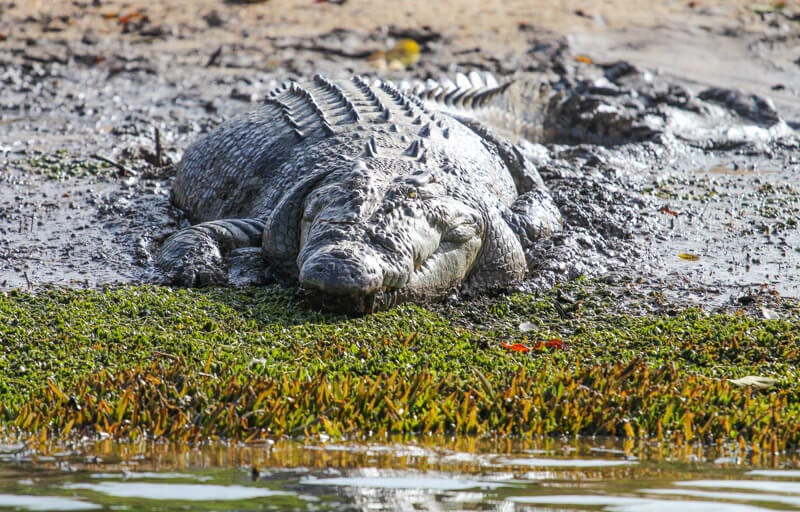
Our afternoon activity was an hour spent on Crocodile Express, the first wildlife cruise operator on the Daintree River in 1979. Led by a local larrikin as our guide we enjoyed learning about the importance of this amazing World Heritage location.
Our guide, who grew up on a property across the river, was an expert on crocs, knew them all by name and their favourite resting spots within the mangroves or where they loved to sun themselves on the sandy river banks.
An excellent tour guide is one of knowledge AND humour – he kept our kids well entertained, and in awe, for the duration of our cruise.
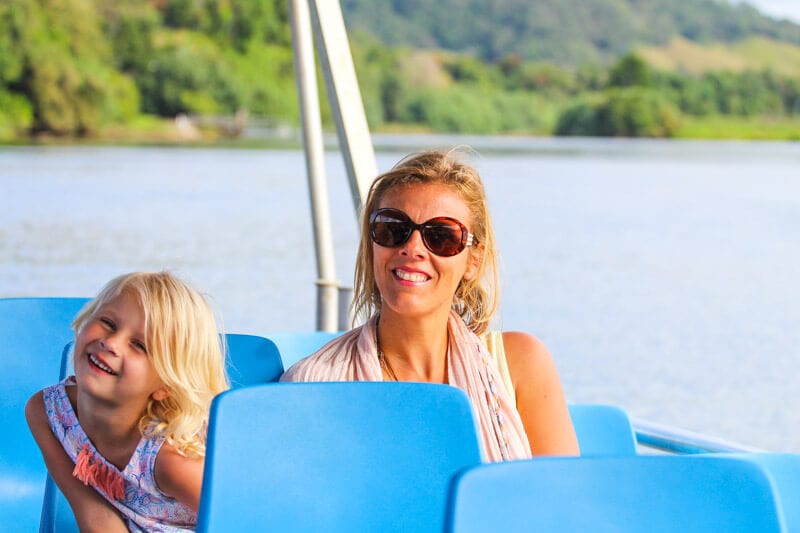

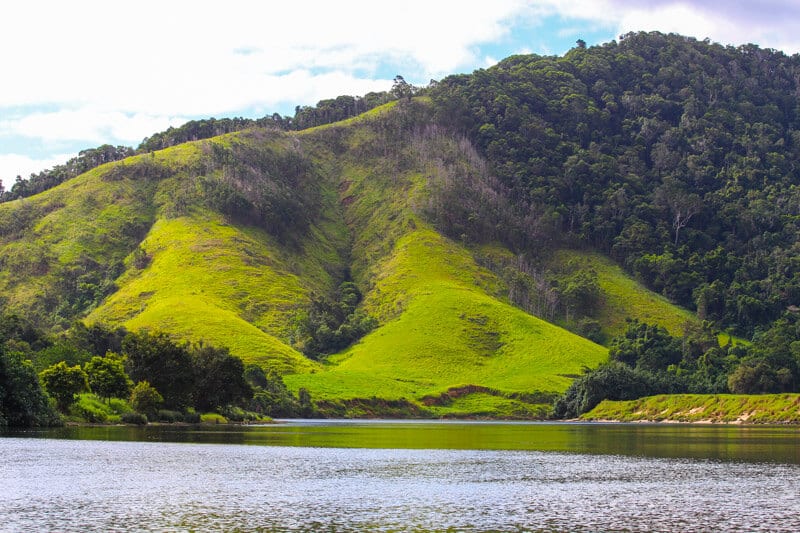
Besides croc spotting, we learned about other wildlife and flora along the foreshore and the river, and the surrounding scenery was beautiful, so lush and green, and added a relaxing element to the cruise.
Crocodile Express departs from Daintree Village (check-in at Daintree Tourist Information Centre in Daintree Village) several times daily.
5. Cross the Daintree River on the Daintree River Ferry
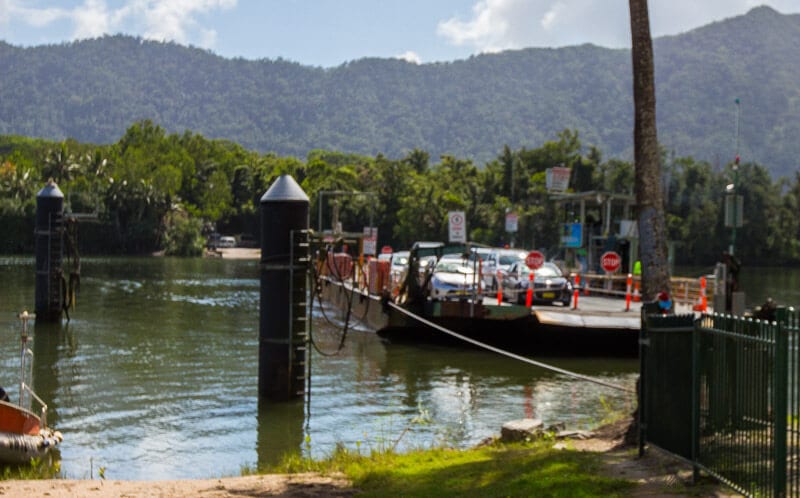
As you cross the Daintree River on the Daintree ferry, you’re about to go deep into the oldest rainforest in the world. It’s time to unplug from all devices (there’s no phone reception) and be at one with nature.
Keep your eye out on the short trip across; you might spot another croc watching the action.
The Daintree River Ferry operates daily between 6 am and midnight ($26 return per car), and you can buy a multi-day ferry pass if you want more time to explore like we did. EFTPOS is available at the ferry between 8.30am-5pm seven days a week.
6. Visit the Mount Alexandra Lookout
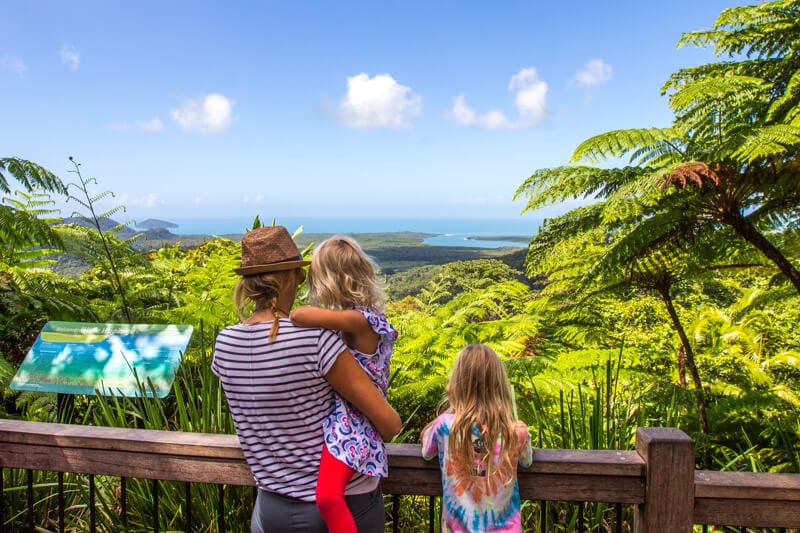
One of the most famous lookout points in the Daintree Rainforest is at Alexandra Lookout, a short drive once you cross over the Daintree River in the car ferry.
From this lookout, you get expansive views out over the rainforest, Alexandra Range, and Snapper Island. It’s a great perspective of where two World Heritage Listed areas collide – rainforest meets the reef.
7. Discover More at the Daintree Discovery Centre

You know a place is engaging and educational when you have to drag your kids out of there.
Our girls loved the self-guided tour, going from number to number, pressing play on their audio guides, and learning all about the 110 million-year-old Daintree Rainforest.
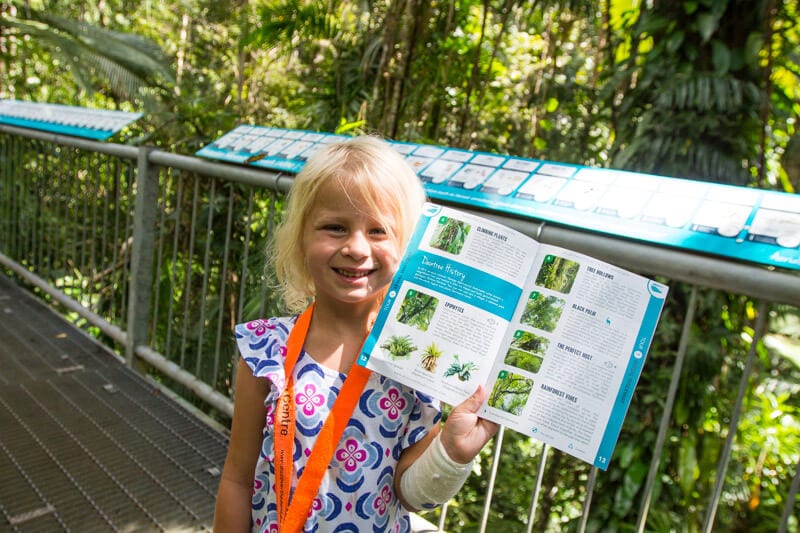
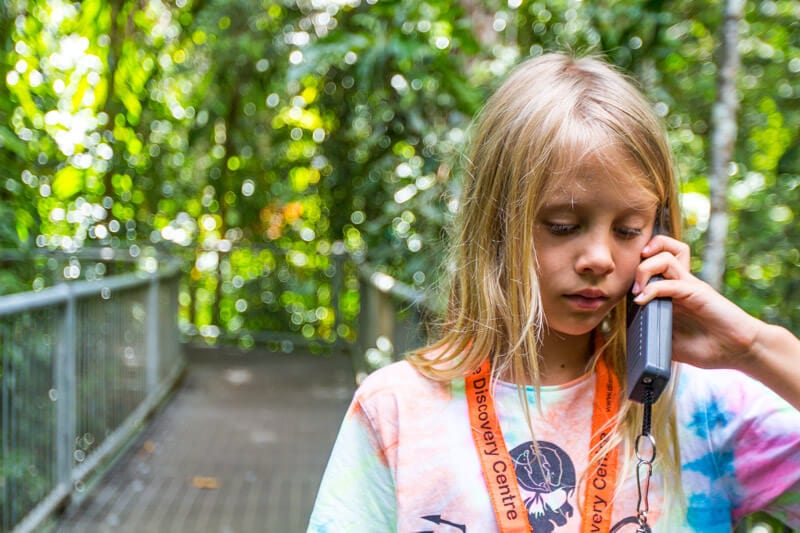
Climbing the 23 metre high Canopy Tower is a must. It has five different viewing platforms with information on each level, and excellent views over the canopy at the top.
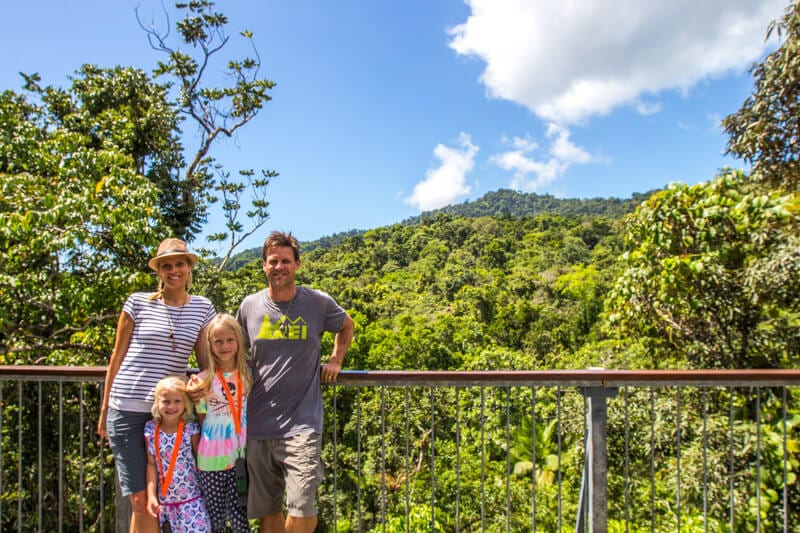
And check out the new Dinosaur exhibit.
Four of the seven models are believed to be remnants of a select group of dinosaurs that lived in various parts of Queensland around the Jurassic Period.

The Daintree Discovery Centre is a “must visit” during your time in the Daintree.
8. Have Lunch at Whet Cafe & Bar

The short pathway through the forest from the car park to Whet Cafe & Bar is another quick reminder you are deep in the Daintree Rainforest.
And the outside deck keeps you immersed in the Daintree providing for a relaxed atmosphere in nature, while indoors is more of a city lounge feel, and as the locals later told us, a favorite bar for evening drinks.
To our delight, whet caters to all specific diets including a gluten-free menu and excellent options for the kids.
10. Walk the Dubuji Boardwalk

We love taking walks with our kids. It’s another great way to bond as a family and let them burn off some energy.
When you visit the Daintree, don’t just drive through it, take every opportunity to get out of your car and get up close and personal with the rainforest.
One of the beautiful Daintree Rainforest walks you can do to experience the region on foot is the Dubuji Boardwalk.
At only 1.2kms it was easy for our kids to manage and winds its way through lowland rainforest swamps and mangroves with some pretty cool trees that offer plenty of shade if you are visiting in warm weather.
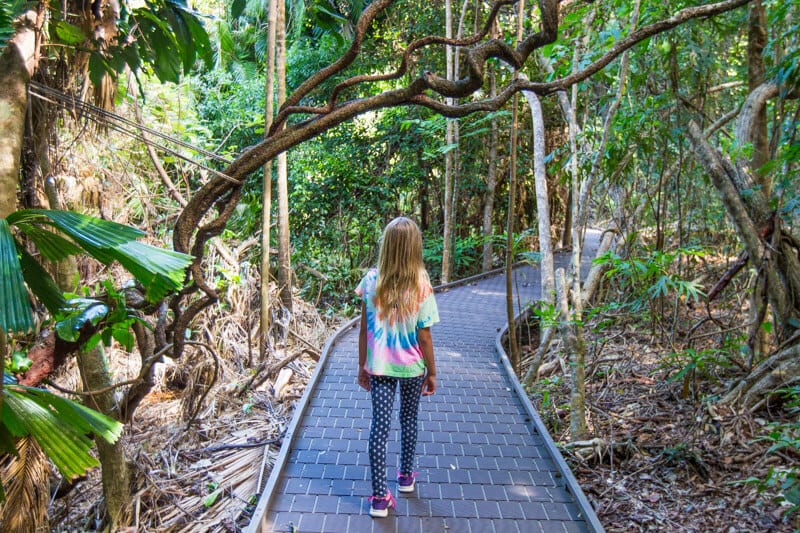

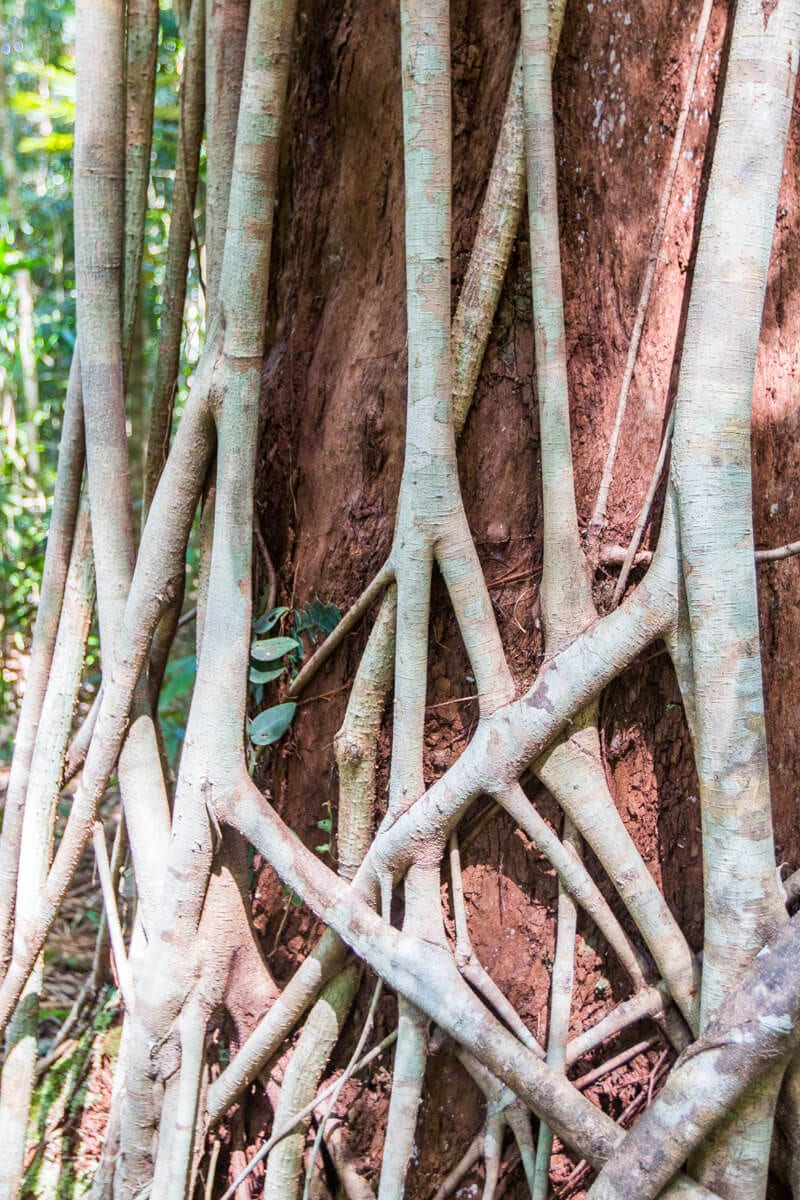

The name Dubuji means ‘place of spirits.’ Part of the track was currently being repaired during our visit, but once fully open leads to Myall Beach.
11. Go Jungle Surfing

At only five years old Savannah amazes us with her bravery and adventurous spirit. As does 9-year-old Kalyra. What will they be doing at 15 and 20?
Yes, you can drive through the Daintree Rainforest, walk through the forest, and climb to the top of the tower at the Discovery Centre, but the most exhilarating experience is jungle surfing (zip lining) high up amongst the canopy.
We had so much fun zooming between the trees with Jungle Surfing Canopy Tours.
Once harnessed up by our enthusiastic guides, the adventure began with us rotating their human-powered Hamster Wheel that takes you up to the first platform.
From there we jungle surfed between six canopy platforms deep in the most ancient section of the Daintree Rainforest.
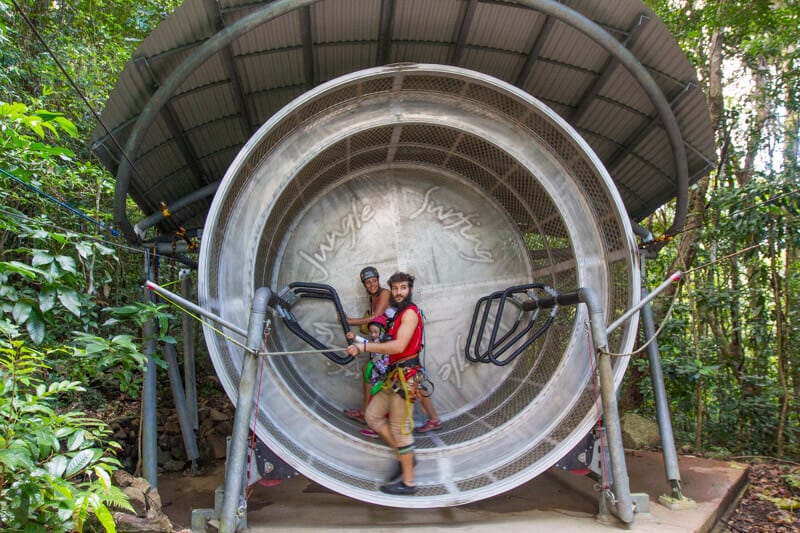
Little Savannah and Kalyra were so brave, going solo, tandem, and even upside down.
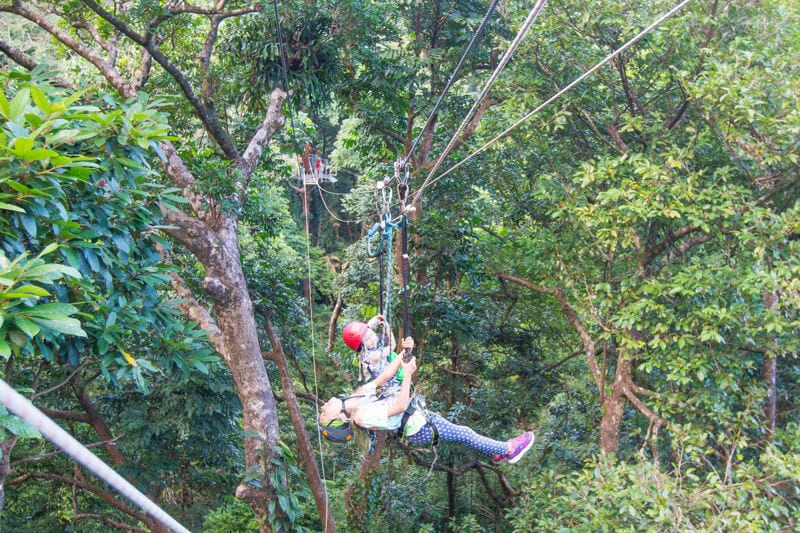
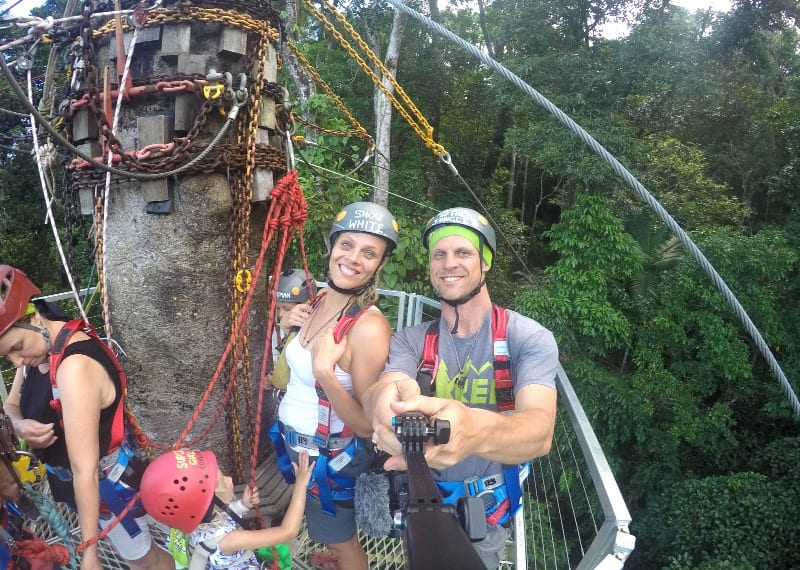
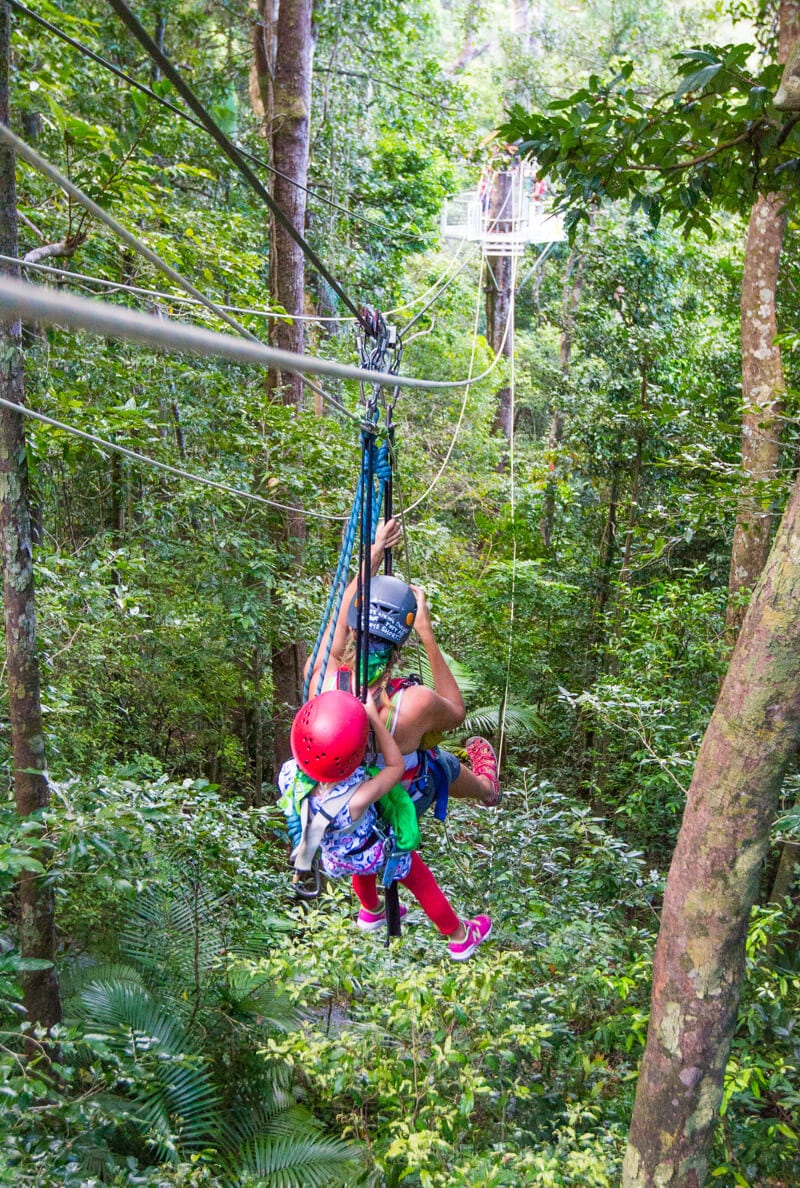
If the only surfing you’ve done is at the beach or on your smartphone, seriously give this a go.
12. Take A Trip to Cape Tribulation Beach

Cape Tribulation is one of the most famous destinations on the Daintree, and we headed straight for the beach to catch the last hour of light and let the kids play in the sand.
An afternoon on Cape Tribulation Beach, with the Daintree Rainforest as your backdrop, is a lot like this.
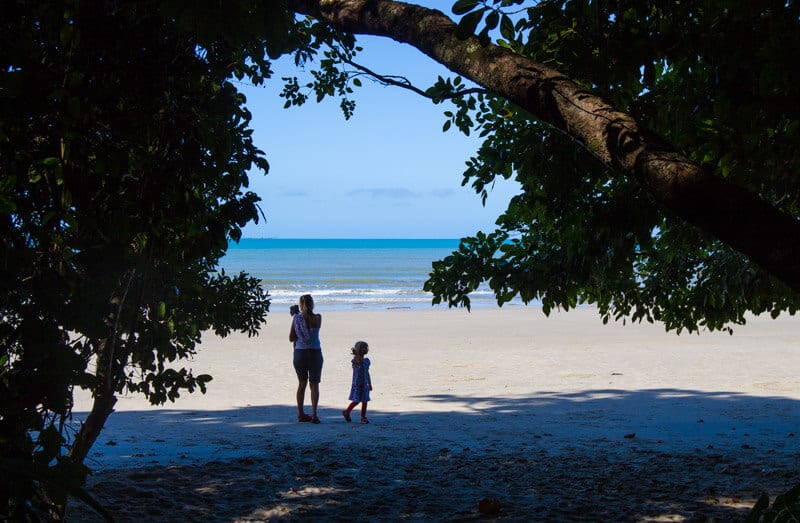
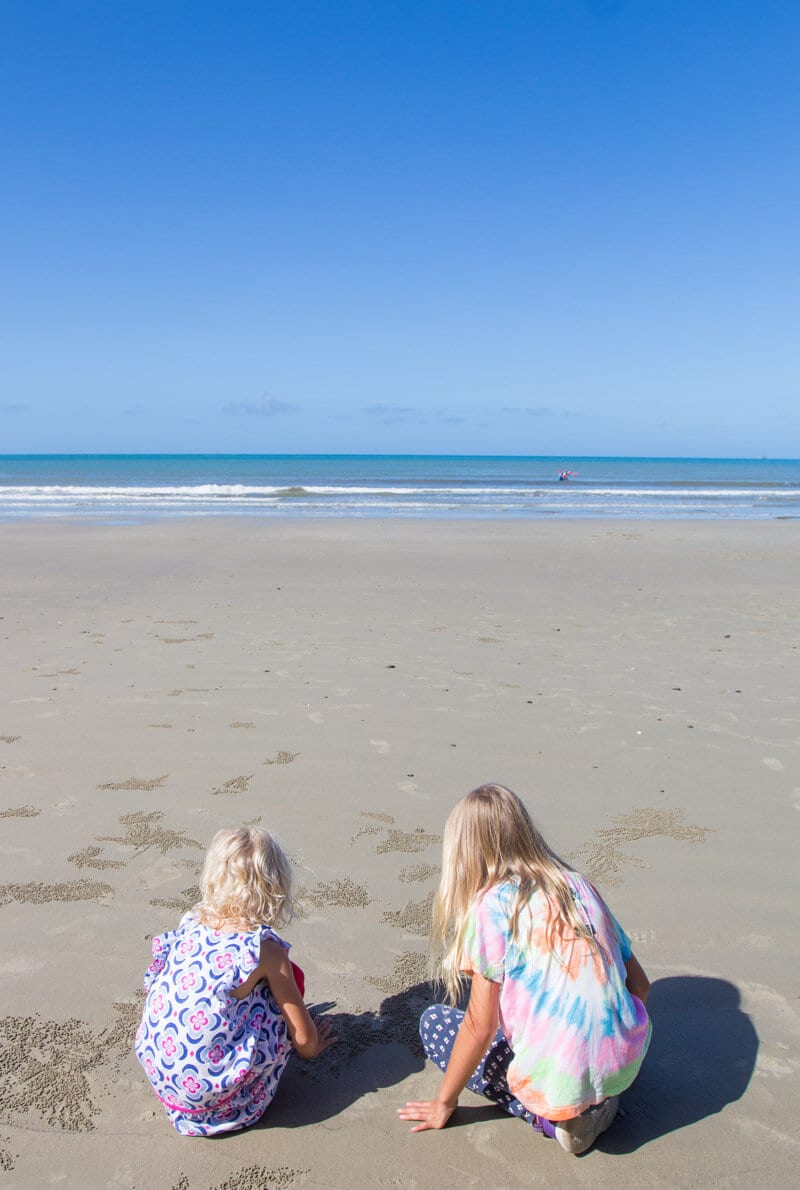
So peaceful and beautiful.
When you walk along the access track from the beach house and out onto the beach, turn left and head north for a few minutes.
You’ll come to these incredible trees our kids loved climbing amongst and which provided some pretty awesome photo opportunities.
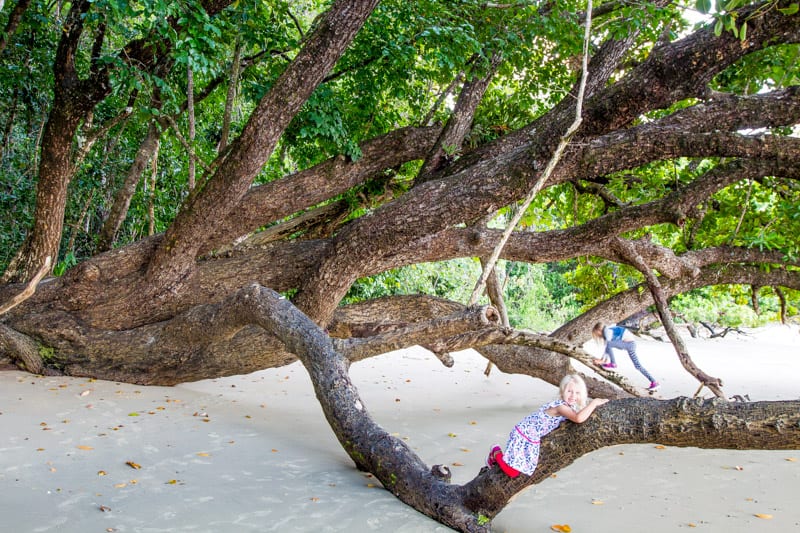

Some other great beaches in the Daintree region are Myall Beach and Cow Bay, which are also beautiful and tranquil.
For adventure lovers, head north of Cape Tribulation for a little further to Emmagen Beach. This is a little, quiet beach that’s right before the road turns to the 4WD-only Bloomfield Track, but also offers a relaxing coastal escape from the forest.
However, it’s not a good idea to go swimming because of saltwater crocodiles and jellyfish.
Still the beaches themselves are like paradise.
13. Have Dinner at Cape Trib Beach House
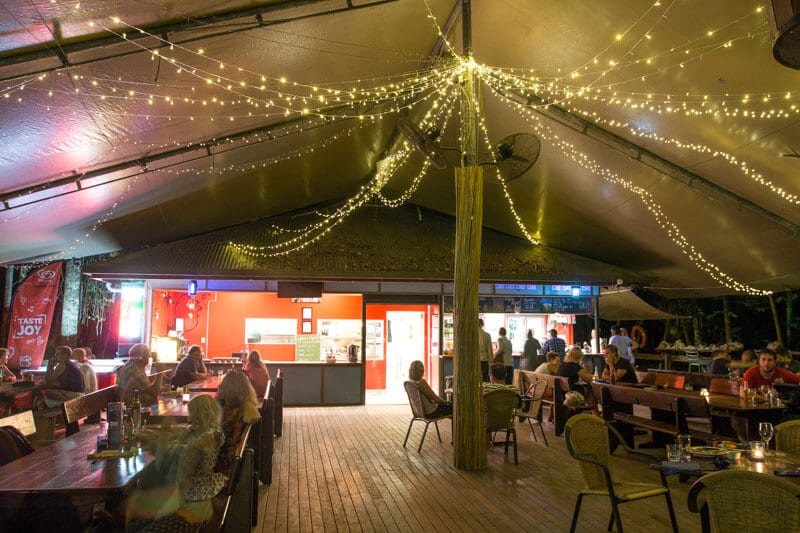
Tides Bar and Restaurant is a super casual outdoor place for a meal set just off the beach and beside the pool at Cape Trib Beach House.
There’s a wide variety of meals on offer, and we were impressed with the quality of size of the dishes. Caz’s kangaroo was cooked to perfection.
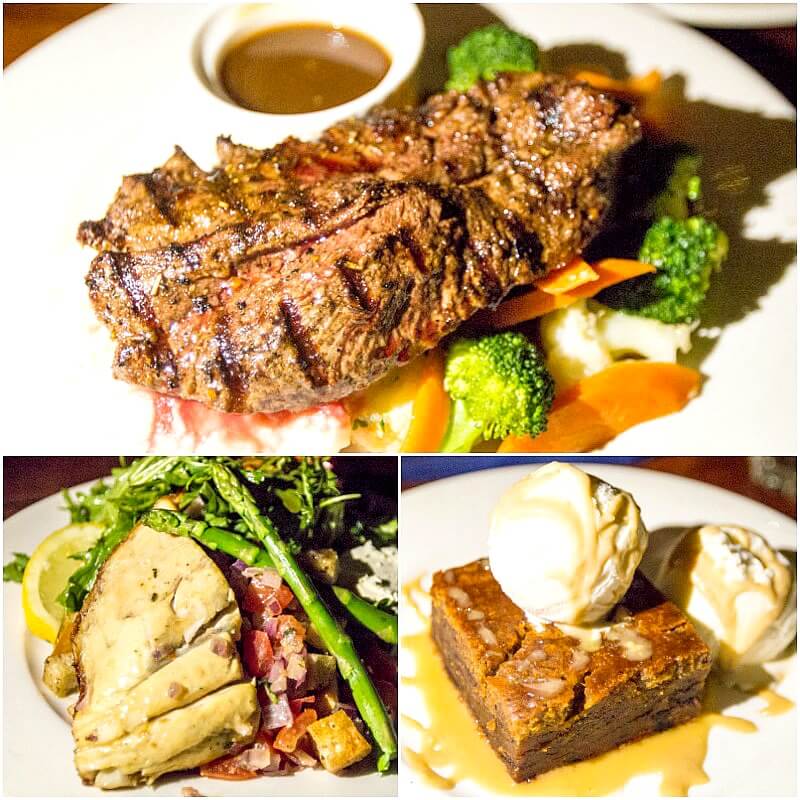
14. Stay Overnight at Cape Trib Beach House
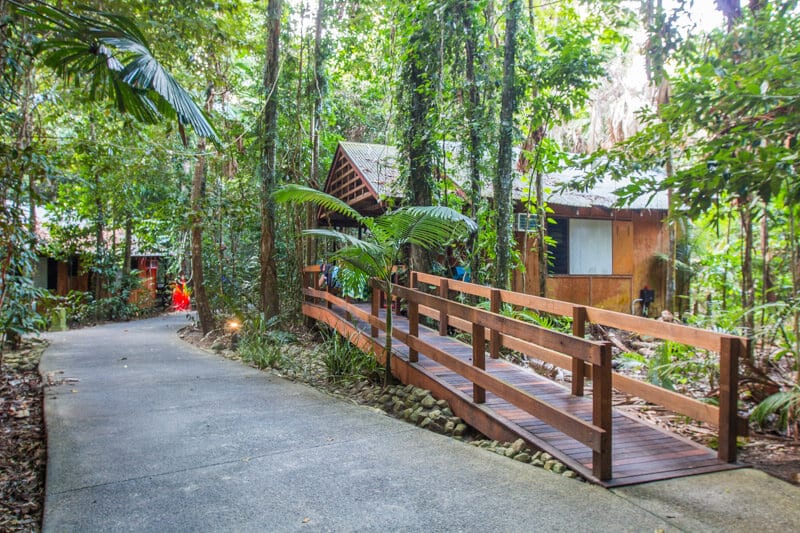
We slept in one of the Escape Family Cabins that came with a double bed and two singles nestled amongst the rainforest and a short walk to the beach.


Cape Trib Beach House is budget-friendly and family-friendly, with a variety of accommodations to suit all travelers from couples, to solo travelers, to backpackers and the location can’t be beaten, especially for the price!
15. Enjoy Sunrise on Cape Tribulation

When you stay at Cape Trib Beach, waking up to sunrise is a spectacular way to start the day and live the magic of Tropical North Queensland.
The sun is golden as it peeks above the horizon and the morning light on the rainforest is spectacular.

16. Walk to Kulki Lookout
After breakfast, walk south along Cape Trib Beach to Kulki Lookout which offers stunning views over Cape Tribulation and the Daintree Rainforest.
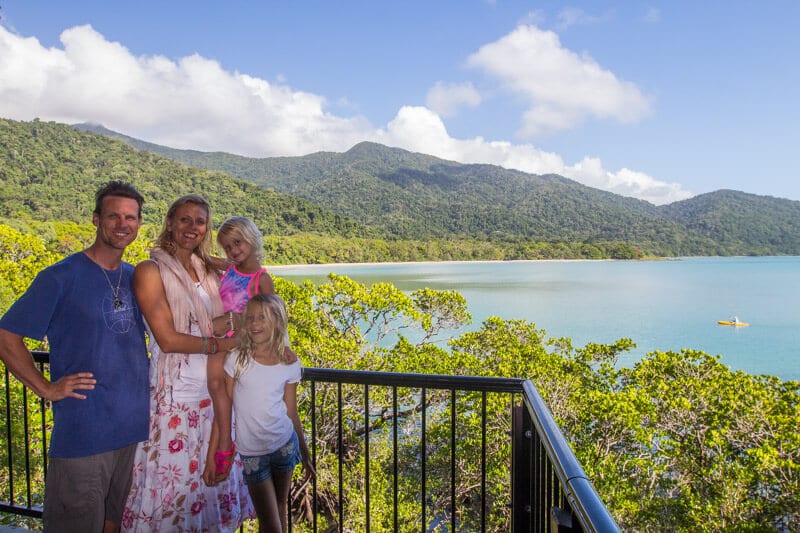
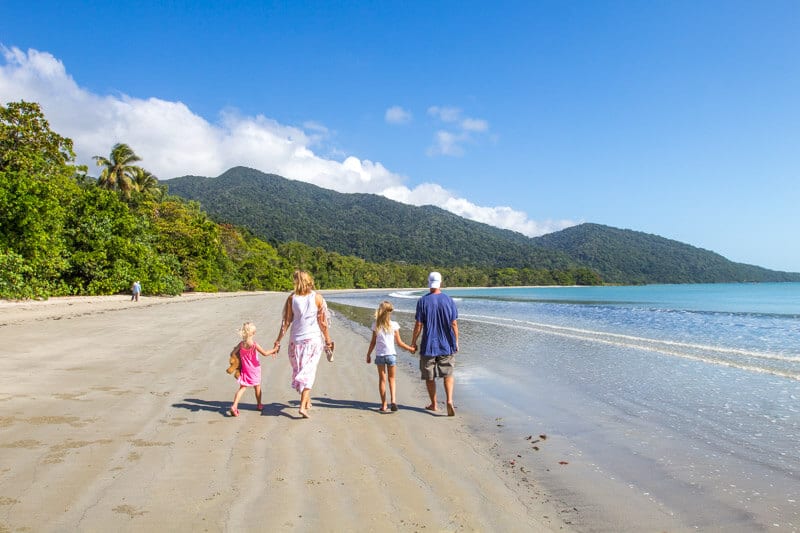
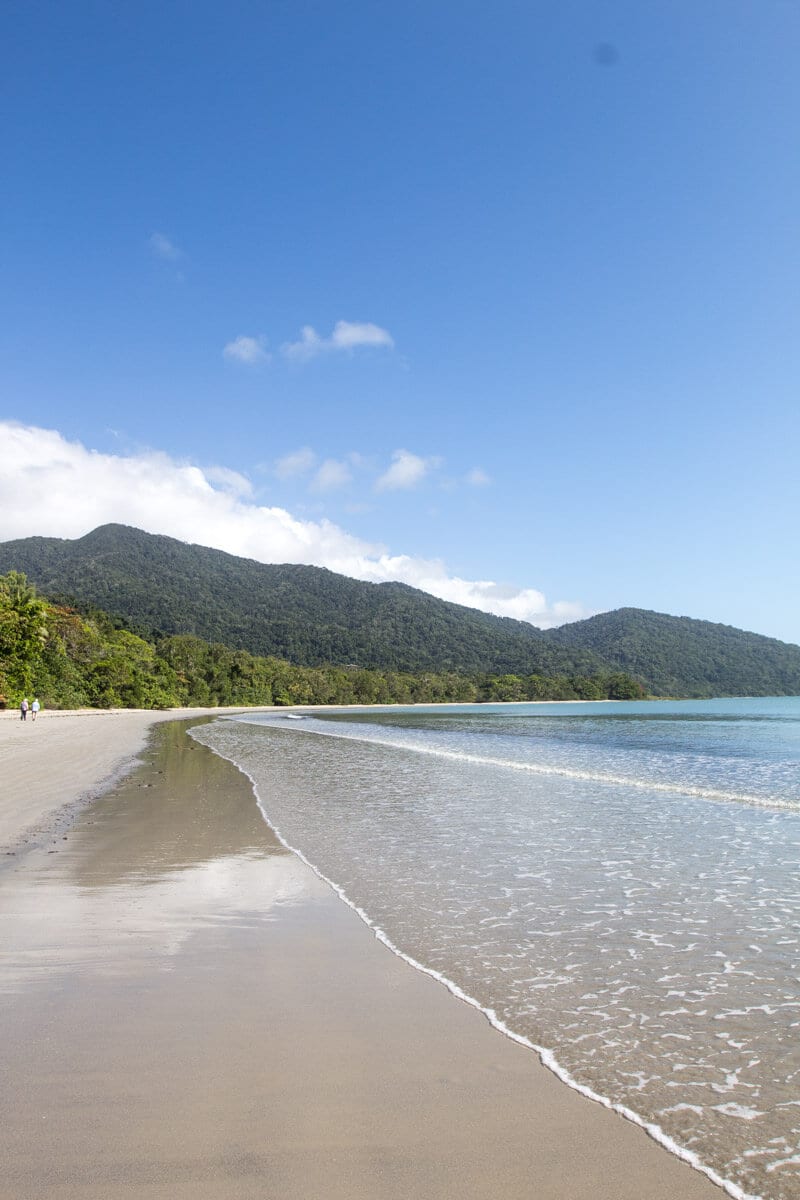
Or if you’re not up for walking, jump in your car at the beach house and drive to Cape Trib Beach car park; then it’s only a 500m walk to the Kulki viewing platform.
17. Have Lunch at Mason’s Store & Cafe
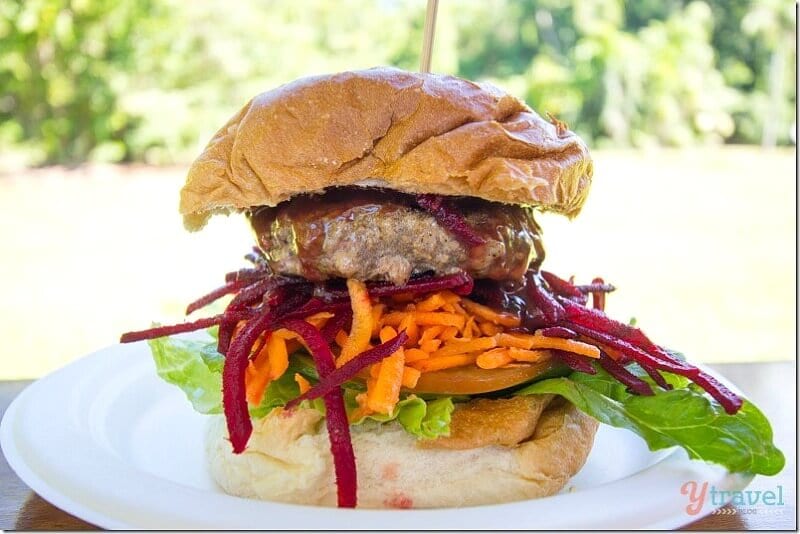
At Mason’s Store & Cafe the burgers are legendary. Pick your animal: wild boar, emu, crocodile, or kangaroo. I went with the emu burger.
It’s a little challenging to get your mouth around their size, but the burgers are nice enough – although I wouldn’t put them into legendary memorable status.
Besides burgers, their menu is quite extensive.

Take a short walk from the cafe to the swimming hole in the creek. It’s very pristine and no one was around when we were there but gets popular in the peak season (gold coin donation) to swim.
18. Walk the Marrja Boardwalk
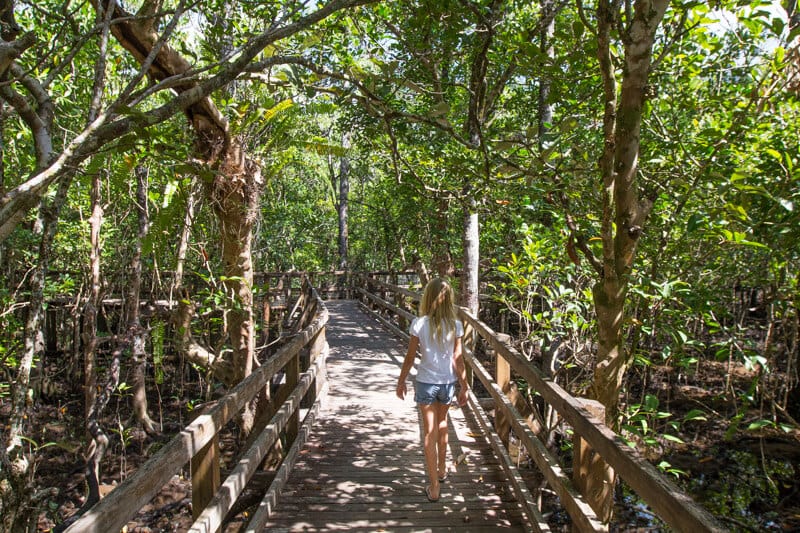
One of the prettiest Daintree Rainforest walks is the 1.2km loop Marrja boardwalk.
It follows the creek through a section of rainforest and past the eerily twisting roots and vines of the mangroves to a lookout over Noah Creek.
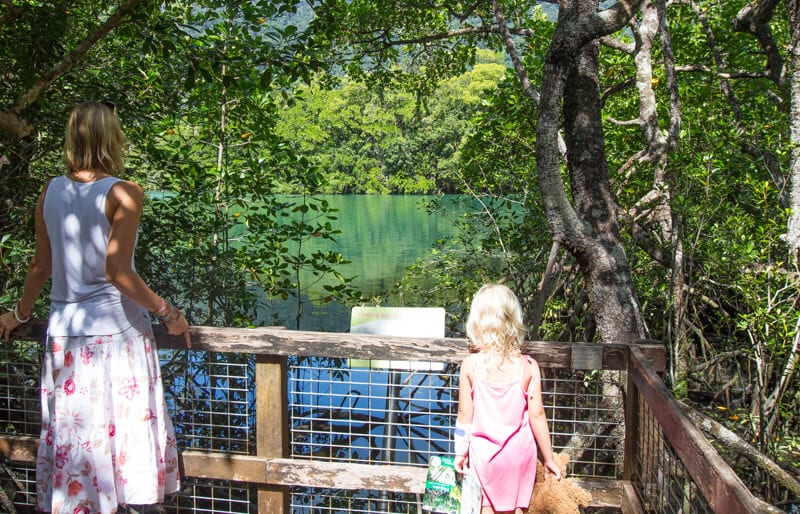

Along this interpretive walk learn about the plant life found in this environment. Your eyes and mind will be fascinated.
19. Try Floravilla Ice Cream
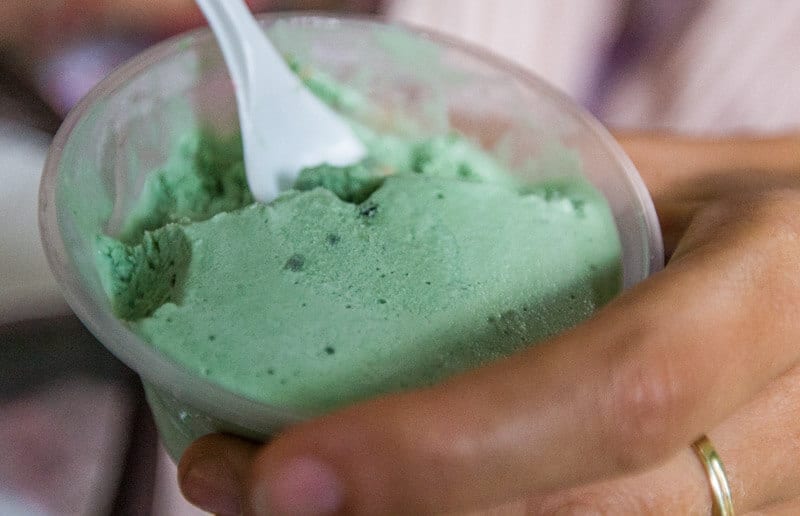
We couldn’t visit the Daintree Rainforest without treating our kids to a specialty local ice cream. And special they are.
Floravilla Ice Cream sells Biodynamic – Organic Icecream from the Daintree Rainforest using all-natural local ingredients that create a unique range of over 26 flavours.
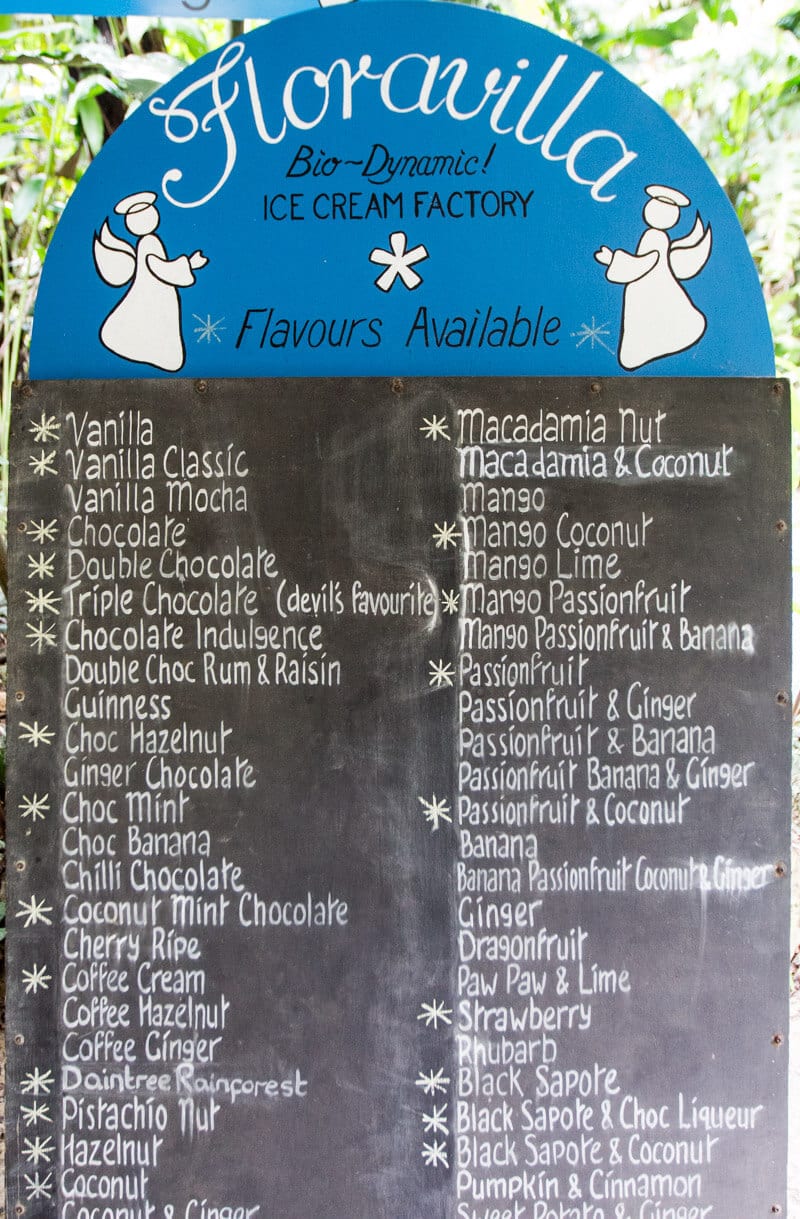
We enjoyed the Daintree Rainforest signature ice cream; it seriously tasted like a Thai green curry. Surprisingly yummy and refreshing! It’s cash only – there’s an ATM a short drive away at the service station.
20. Thornton Beach Cafe
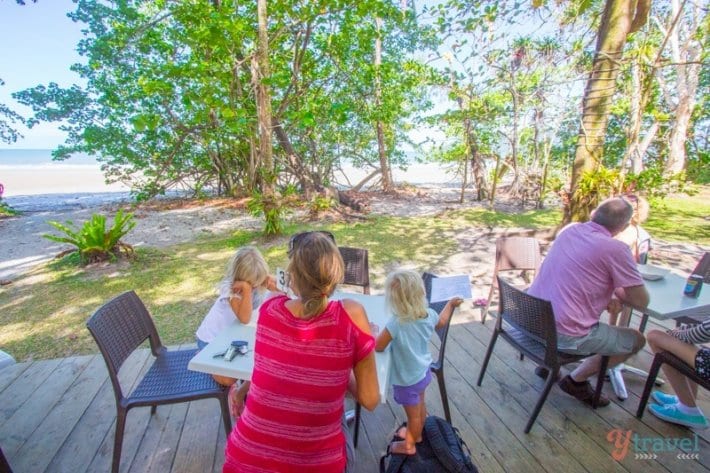
The Thornton Beach Cafe is a lovely spot to stop for lunch or breakfast right on Thornton Beach.
Try the Thai fish cake burger – delicious. The only downside to this cafe is the toilet block is currently under construction so you have to use the porta-loo.
21. Look out for Idiot Fruit
No, idiot fruit is not going to turn you into an idiot, it’s actually a very rare flower that grows in the ancient rainforest.
Idiot fruit, or Idiospermum australiense, is one of the rarest flowering plants in the world and has been on this earth for more than 110 million years. This is why it’s sometimes referred to as the “green Dinosaur” because of how old it is.
It’s believed the name “idiot fruit” comes from the Latin name “idios” which means “individuality” or “peculiarity.” So sadly, there are no funny stories about how it was not found by the village idiot.
The plant is actually very generic-looking. It grows on an evergreen tree and has small white flowers. Visitors rarely see it grow by themselves, so if you want to see it, it’s best to go with a guide.
Where to Stay in The Daintree Rainforest
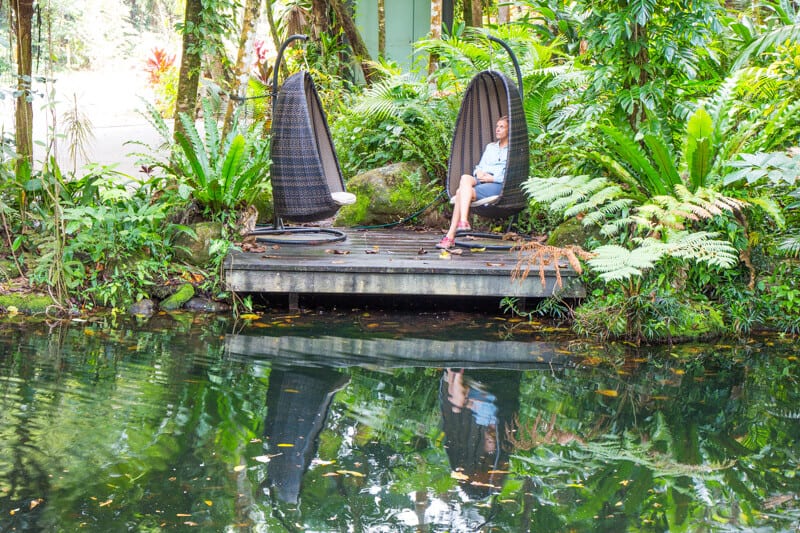
When it comes to choosing a place to stay in the Daintree, a stay at The Daintree Ecolodge is a must. It’s located in the heart of the rainforest and offers luxury, eco-friendly, and boutique accommodations.
The lodge also has 15 bayans (treehouses) which are hanging in the rainforest canopy, so you can really feel like you’re staying in the rainforest.
The lodge has its own sacred, private waterfall, a wellness spa, and the onsite Julaymba Restaurant.
Talk about escaping city life and getting back to nature – like I said, if you’re going to visit the Daintree, you may as well sleep immersed in the rainforest. Serenity at its best.
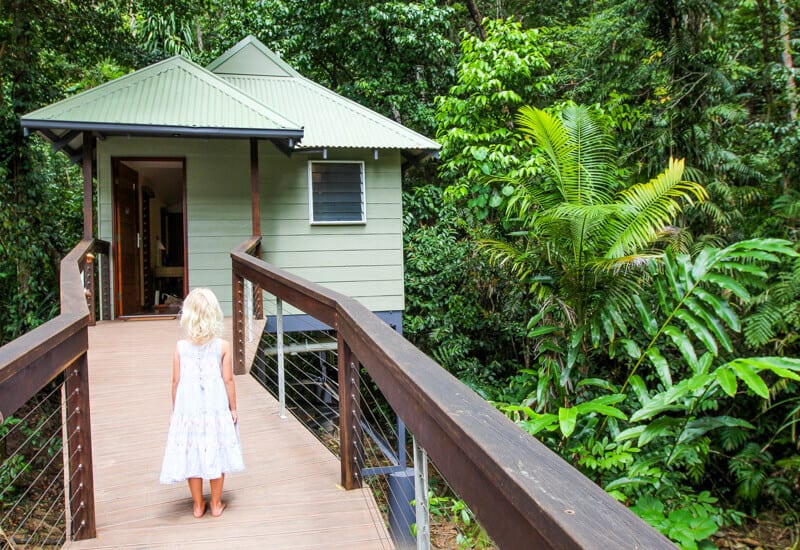
The kids and us big kids could hardly contain our excitement as we moved into our lodges immersed and surrounded by lush greenery.
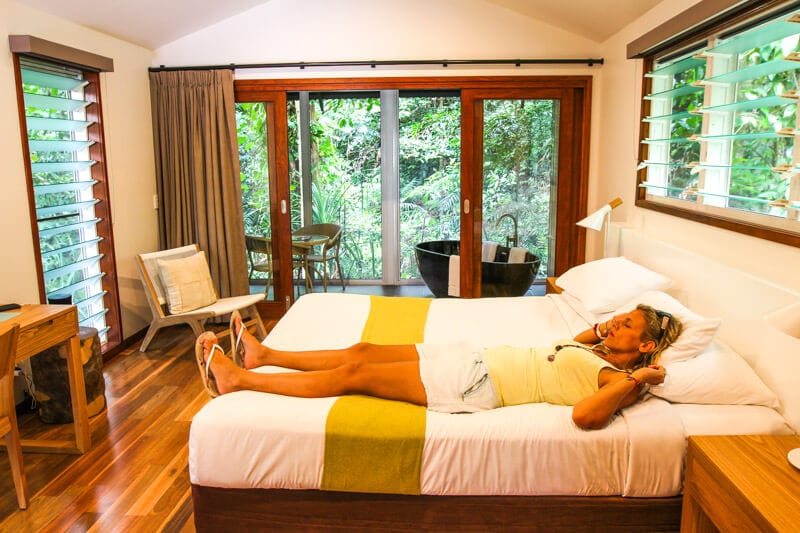
We took advantage of an hour of relaxation. The kids played in their lodge, Caz relaxed on our balcony and I did some gentle exploration and walked the path up to the waterfall – a waterfall visited over thousands of years by generations of Aboriginal women who came to the special place and were at one with their spirit.

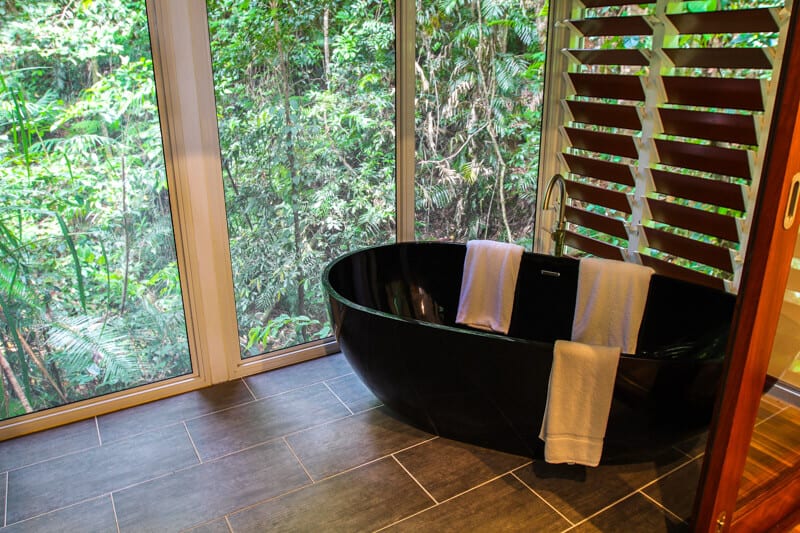
Even if you don’t stay at Daintree Eco Lodge & Spa, the meals in the restaurant are well worth the visit, and a favourite dining venue for the locals. The setting by the pond is serene and the food top notch.
We thoroughly enjoyed our seared scallops, kangaroo fillet, and desserts.
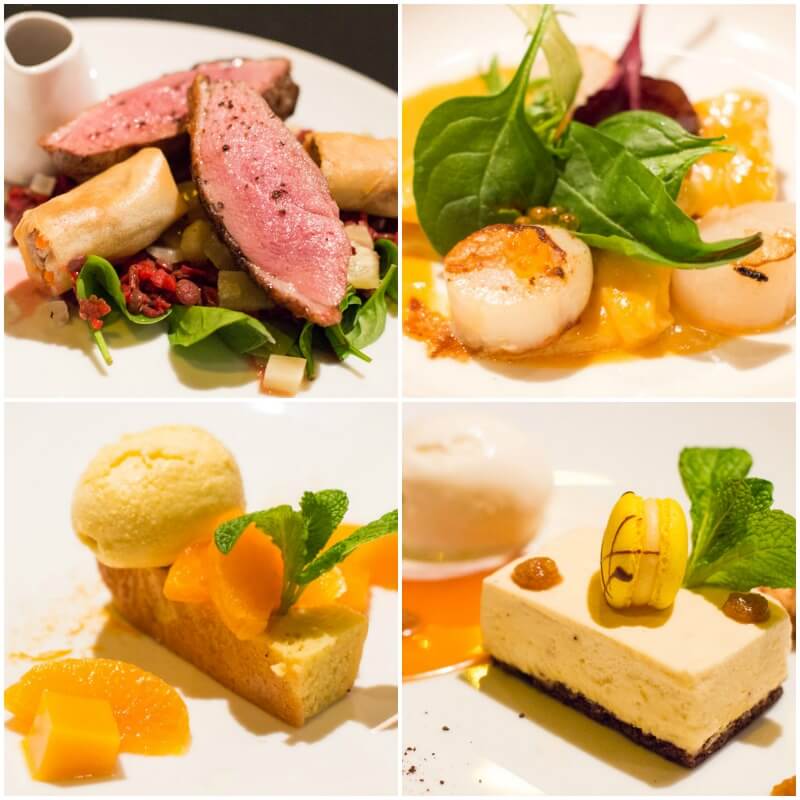

When you awaken, breakfast is served by the pond, and you’re just around the corner from the Daintree River Ferry that takes you and your car deep into the rainforest.
Daintree Eco Lodge: Read reviews and check availability and prices
Final Word on Visiting The Daintree Rainforest
So there you have it, this is everything you need to know about visiting the Daintree and all the things you can do in the region.
As you can see, it’s more than just a rainforest, but is a huge area home to fantastic beaches and thrilling adventures.
We hope you found this guide useful and helped you plan your visit.
Daintree Rainforest Videos
Want more inspiration on the Daintree Rainforest? Check out our YouTube video of us exploring the Daintree Village, the Daintree Rainforest, and staying on Cape Tribulation Beach. Subscribe to our YouTube channel
Tropical North Queensland Tips
If you’re planning on visiting other parts of the Tropical North, then you might find the below resources helpful…
Save It On Pinterest

Have you visited the Daintree Rainforest? What was your highlight? Let us know in the comments!
Hi, guys! I just wanted to thank you for your great blog. I’m from Argentina and I’m currently planning my trip around Australia. All your posts have been of so much help! You can’t even imagine. Thanks for sharing. And keep having fun!
Hi Ercilia,
So happy to hear that. Excited you are planning a trip around Australia and you have found our blog helpful. Don’t miss the Daintree Rainforest 🙂
I LOVE the whole area and enjoyed your post …brought back memories from last year. Zip Lining though ..NO CHANCE as my feet would have to leave firm ground!!!
Haha, I understand your fear of heights Angela. But glad you share a love for the Daintree Rainforest. Hope you get to experience it again soon.
Wow, this place looks unreal. The accommodation is truly incredible; right amongst it all. Love the look of the Jungle surfing too. Thanks for the fantastic photos; you always do these places justice!
Hey Aaron,
Yep, the jungle surfing was awesome, and the accommodation. Hope you make it to the Daintree Rainforest and experience it all for yourself.
The Daintree is one of the most magical places in the world to visit. D yourself a favour and put it on your bucket list.
Absolutely. Everyone should visit the Daintree Rainforest at least once 🙂
This post convinced me that we need to go back to Australia again. This place might not be in the guidebooks or top-places-to-see lists, but it looks like one of those amazing destinations that give you a true Australian experience. Pinning it for later!
Hi Jurga. Well the Daintree Rainforest most certainly should be in every guide book top places to visit list. Glad it’s inspired you to visit Australia again!
I’ve been with the kids and it worked so well. paul was away so it was just me with the four, two teens and I think the twins were 8 or so. There’s something for every kid and every kid loves a croc… and the ice cream.
BUT we did it as a day trip – with a fab guide, I must say… I’d SO love to spend longer up there… on the list
Thank you sooooo very much this is really really helpful!!
Glad to help Karen 🙂
A lot of great information, thank you!
I really want to visit Daintree, but I don’t drive. Is there absolutely no way to get there by public transportation/shuttle service from Port Douglas?
Yes. you can join tours. Check out this one on Viator https://www.partner.viator.com/en/22559/tours/Cairns-and-the-Tropical-North/2-Day-Cape-Tribulation-and-Daintree-Rainforest-Small-Group-Tour-from-Cairns-or-Port-Douglas/d754-5457JGW2
I am not sure about public transportation though.
Wow! Just wow! The Eco Lodge looks amazing, the rainforest looks amazing, the zip lining looks amazing – I want to do it all! It looks absolutely beautiful there, thank you for sharing 🙂